Because of its warm, wet climate, South Florida is a welcoming environment for many tropical plants. I’ve written about a few of the flowering trees that have been introduced here, among them the gloriously yellow-flowered Tabebuia and the spectacular orange Royal Poinciana. The poinciana has a simply spectacular bloom a few times a year, blazing orange or red in a simply unbeatable show.
We have one on the west side of our property, right next to the driveway. It’s a beautiful sight from our bedroom windows, with birds flitting in and out of the branches, and the flowers providing sunset colors all day long:
Our tree has become sort of a neighborhood landmark; the couple across the way got married in this very house decades ago, and have watched this tree bloom every rainy season for nearly 50 years. Apparently, so they tell me, when the house was renovated about a dozen years ago, the owners put in a stamped concrete driveway right over the root zone, which reduced the area from which the tree could draw water (yet another of the disadvantages of hardscape as opposed to landscape). Ever since then, the tree has struggled. We’ve had some pretty severe droughts in the last 10 years, and the homeowner before us was, shall we say, not interested in upkeep, either of the house or the landscape. So the tree’s been through a lot recently.
But it’s still quite a tree: over eight [UPDATE: it only seems that big; it’s more like two-and-a-half] feet around at breast height, with a crown probably 40 or 50 [UPDATE: 25 to 30] feet in diameter. It covers quite a bit of ground.
Now, as I wrote last year, these trees look pretty scraggly when they’re not in bloom. Look at this image, taken March 27, 2011:
Not very showy, right? But take a closer look (just click on the image): almost every branch ending has lots of new leaf growth, promising great things to come. And, as the first picture shows, it delivered.
This year, though, the tree is really starting to look worrisome. Instead of hundreds of leaf buds, I’ve seen only two or three twigs attempting to leaf out; the rest are all dry and brittle:
All those starlings have been roosting and nesting in the various holes around the tree. There are over a half dozen of these holes, and each one is actually an old wound that hasn’t healed. A tree can sustain some hollows, but it seems like every major branch coming up from the main crotch of the tree has these hollows.
Even the holes in the bark that aren’t hollow are starting to get pretty scary:
And if that’s not enough, there’s a really scary-looking fissure at the main crotch of the tree:
Things are so bad that, on my neighbor’s recommendation, I brought a tree service in to see if there was something that could be done. He pointed out all the problems noted above, and noted the gaping hole at the base of the tree, about a foot wide and four or five feet tall, that has been there for years. Previous tree services have said that it’s OK, but this arborist reached in and pulled out some wood and noted what looked like termite damage; a worrisome sign if ever there was one.
He pointed out something else that I don’t know I’d ever have thought to look for: right away, as soon as he arrived, he said that all the seed pods were undersized. To me that means the tree hasn’t been doing well for quite some time. It can’t even find the energy to put into reproduction, let alone beautiful flowers.
The arborist’s recommendation was stark: remove the tree and grind the stump. The other option he gave us was to try to do “crown reduction,” to prune the dead limbs and restore some sort of balance to it, but he didn’t hold out much hope for that plan.
I realize that it’s the Easter season (tonight there was a gorgeous paschal moon) and talk of resurrection is in the air, but I’m not convinced that this tree is a good candidate for bringing back from the dead.
Of course, either way, he makes his fee: about $1000 to take the tree out, versus $600/year for a couple of years to try to bring the tree down to a safe level without killing it from shock.
So, yeah, it’s safe to say that this Delonix regia qualifies as one royal pain-ciana.

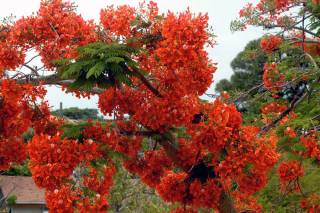
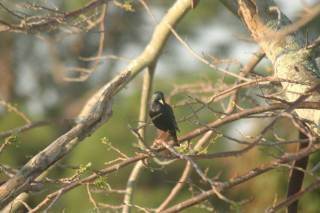
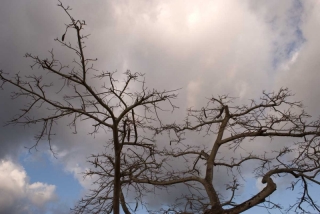
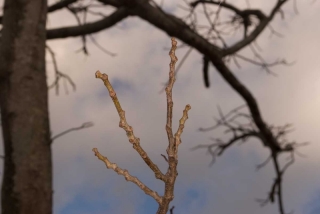
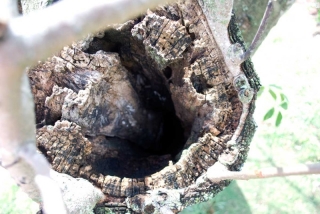
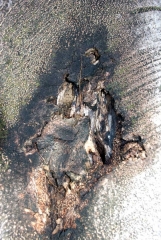
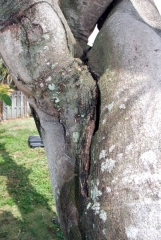
Ben, I am so sorry to hear this! I LOVE that tree!
It was such a beautiful tree. We’re giving it a few more weeks to see if there’s any life left in it at all, but I don’t have very high hopes.